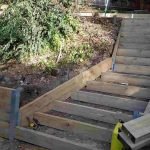Introduction
When it pertains to landscaping and home management, retaining walls play an important role. These structures are necessary for managing soil erosion, developing usable land space, and even enhancing the visual appeal of your home. Nevertheless, the effectiveness and longevity of a retaining wall hinge substantially on one important aspect: planning This short article delves deep into the value of correct preparation by your retaining wall home builder and how it can make or break your project.
Why Appropriate Planning by Your Retaining Wall Contractor is Crucial
Proper planning by your retaining wall contractor is crucial for several reasons. Firstly, without a well-thought-out plan, you run the risk of the wall stopping working to perform its designated function-- supporting soil and avoiding erosion. An inadequately designed or built wall could result in serious problems like structure damage, landscape deterioration, or perhaps safety hazards.
Furthermore, planning encompasses numerous aspects such as material selection (timber sleeper vs. concrete sleeper), structural integrity (utilizing H beams), drain considerations, and visual aspects. By understanding these aspects upfront, you can save yourself money and time in the long run while ensuring a durable structure that satisfies all your needs.
Understanding Different Types of Keeping Walls
1. Timber Sleeper Walls
Timber sleeper walls are popular for their natural look and versatility. They integrate magnificently with gardens but need meticulous preparation to ensure they can withstand the pressures of soil.
- Advantages: Visual appeal, economical. Disadvantages: Susceptible to rot if not properly treated.
2. Concrete Sleeper Walls
Concrete sleeper walls offer superior strength and resilience compared to timber choices. They are ideal for high-load scenarios however can be more expensive.
- Advantages: Durability, minimal upkeep required. Disadvantages: Greater preliminary cost.
3. H Beam Reinforced Walls
For substantial load-bearing applications or in locations vulnerable to heavy rains, making use of H beams supplies unrivaled structural support.

- Advantages: Exceptional strength. Disadvantages: Requires proficient labor for installation.
Key Factors in Planning Your Retaining Wall
4. Soil Analysis
Conducting a thorough soil analysis is important. The type of soil will dictate the design requirements for your retaining wall.
- Clay soils might broaden when wet however diminish when dry. Sandy soils drain well but might not provide appropriate support.
5. Drain Solutions
Including efficient drain services in your plan is non-negotiable! Water buildup behind a retaining wall can cause it to stop working catastrophically.
Types of Drainage Solutions
- Weep holes Drainage pipes Gravel backfill
The Value of Regional Regulations
6. Building Codes and Permits
Before commencing any building job, familiarize yourself with regional building regulations and allowing procedures connected to maintaining walls.

- Ensure you're compliant with height restrictions. Some areas might need engineering assessments for taller walls.
Working with Specialists in Retaining Wall Construction
7. Selecting the Right Builder
Selecting a knowledgeable professional for constructing your retaining wall is necessary! Look for qualifications that reveal expertise in handling both timber sleeper and concrete sleeper options.
Questions to Ask Possible Builders
What kinds of materials do you specialize in? Can you provide references from previous projects?Design Considerations in Your Retaining Wall Plan
8. Aesthetic Integration with Landscape Design
Your retaining wall ought to not simply be functional; it must likewise boost the beauty of your landscape!
Tips for Visual Integration
- Choose products that complement existing features. Incorporate plants or decorative stones around the base for additional charm.
Cost Estimation and Budgeting
9. Comprehending Job Costs
Budgeting efficiently includes comprehending all possible expenses related to constructing a keeping wall.
|Cost Component|Approximated Range|| ---------------------|-------------------|| Product Costs|$50 - $150 per sq feet|| Labor Expenses|$30 - $100 per hour|| Permit Charges|Differs by place|
FAQs about Maintaining Walls
1. What is a retaining wall's primary purpose?
A retaining wall's primary function is to keep back soil from eroding or collapsing into lower locations on a https://jsbin.com/jasoqizivi home while also creating usable flat surfaces for landscaping or building purposes.
2. How do I select in between timber sleeper and concrete sleeper walls?
Consider elements such as aesthetics, budget plan restraints, sturdiness requirements, and upkeep preferences when deciding between timber sleeper and concrete sleeper walls.
3. Can I construct a retaining wall myself?
While do it yourself tasks are tempting to save costs, it's a good idea to seek advice from specialists who possess knowledge about structural integrity, drainage solutions, and regional policies to prevent future problems.
4. For how long does a correctly prepared retaining wall last?
With correct building and construction using quality products like concrete sleepers or treated timber sleepers along with great drainage systems, a well-planned retaining wall can last upwards of 20 years or more!
5. What happens if my retaining wall fails?
If your retaining wall stops working due to poor preparation or execution, it might cause significant home damage including erosion problems that impact landscaping and even home foundations-- leading possibly pricey repairs!
6. How frequently need to I check my retaining wall?
It's smart to examine your retaining wall at least when a year after heavy rains or storms considering that these events can jeopardize structural integrity over time.
Conclusion
In summary, correct preparation by your maintained wall contractor can not be overemphasized! By meticulously thinking about factors such as product choice (timber sleeper versus concrete sleeper), drain options, local policies compliance; you'll lead the way towards achieving a visually pleasing yet robust structure that stands versus time's test-- a real testimony not just of performance however also artistry within landscape architecture! So don't rush through this vital stage-- take time now so you will not regret it later!
This extensive guide acts as a vital resource whether you're considering installing a new retaining wall or looking into adjustments on an existing one; keep in mind that investing effort into thoughtful preparation today will pay dividends tomorrow!